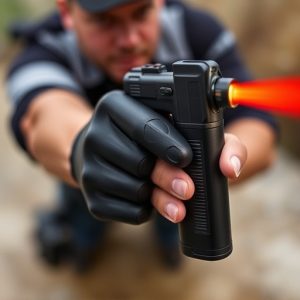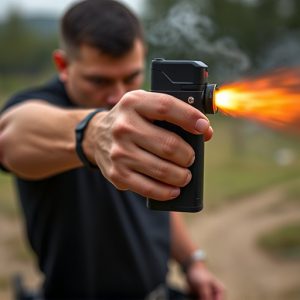Unveiling OC Spray: Potency, Science, and Police Grade Differences
OC spray, a powerful law enforcement tool, utilizes capsaicin, the heat-inducing compound from chili…….
OC spray, a powerful law enforcement tool, utilizes capsaicin, the heat-inducing compound from chili peppers, in concentrations ranging from 1% to 2%. These levels determine its effectiveness for crowd control and self-defense, with higher concentrations (2%-5%) reserved for police-grade spray. Correct usage involves targeting the eyes and face, but it carries risks of temporary blindness, breathing difficulties, and severe discomfort if mishandled. Responsible use requires understanding capsaicin concentration levels and adhering to safety precautions outlined by manufacturers.
“Uncover the powerful world of OC spray, a critical tool in law enforcement and security. This comprehensive guide delves into the science behind capsicin, its primary active ingredient, and how concentration levels impact effectiveness. From understanding police-grade OC spray’s unique properties to exploring safety guidelines for responsible usage, this article provides an in-depth look at capsaicin’s role as a non-lethal force multiplier. Discover the nuances of different concentrations and their implications, offering valuable insights for professionals and enthusiasts alike.”
- Understanding OC Spray: A Comprehensive Overview
- The Science Behind Capsaicin: What is it and Why is it Used?
- Deciphering Concentration Levels: What Does OC Spray Potency Mean?
- Police Grade vs. Commercial Varieties: Uncovering the Differences
- Safety and Usage Guidelines: Responsible Handling of Pepper Spray
Understanding OC Spray: A Comprehensive Overview
OC spray, short for oleoresin capsicum spray, is a powerful tool used by law enforcement agencies worldwide. It’s an aerosolized solution derived from chili peppers, containing capsaicin—the compound responsible for the spicy sensation in chili fruits. The OC spray’s effectiveness lies in its ability to cause temporary but intense irritation and pain, disabling suspects without causing serious harm.
The capsaicin concentration levels in OC spray vary, typically ranging from 1% to 2%. This concentration is designed to overwhelm sensory perception, making it an effective crowd control measure and a less-lethal alternative to firearms. Understanding these chemical aspects of OC spray is crucial for both law enforcement professionals and the public, as it underscores the importance of responsible use and highlights potential risks and safety precautions associated with this controversial yet widely adopted tool.
The Science Behind Capsaicin: What is it and Why is it Used?
The Science Behind Capsaicin: Unraveling the Powerhouse in OC Spray
Capsaicin, the key ingredient in pepper spray, is a natural compound derived from chili peppers. It’s what gives them their heat and pungent aroma. In the context of law enforcement, capsicin is utilized due to its ability to induce a powerful reaction in humans when exposed. This compound activates nerve endings in the skin and eyes, leading to temporary but intense discomfort, pain, and blindness. The effect is rapid and can last for several minutes, providing officers with a crucial tool for self-defense and crowd control.
OC spray, or oleoresin capsicum (OC) spray, contains capsaicin at various concentration levels, typically ranging from 1% to 2%. This concentration determines the strength of the spray’s impact. Higher concentrations can cause more severe reactions, making it essential for officers to understand and respect the power they wield. The science behind capsain offers a glimpse into the effective yet controversial tool used in law enforcement around the globe.
Deciphering Concentration Levels: What Does OC Spray Potency Mean?
OC spray, a common tool among law enforcement agencies, is more than just a chemical irritant; it’s a precise formula designed to disrupt and subdue individuals while ensuring officer safety. At the heart of OC spray’s effectiveness lies its capsaicin concentration levels—a crucial factor determining potency. Deciphering these levels involves understanding how much capsaicin, the active ingredient, is present in each spray canister.
Capsaicin concentration is measured in parts per million (ppm), indicating the number of milligrams of capsaicin per 100 milliliters of the spray solution. Higher ppm values signify greater potency, meaning the spray will have a more intense and longer-lasting effect on the target’s eyes, nose, and respiratory system. This concentration plays a vital role in the spray’s ability to incapacitate individuals swiftly and effectively during tactical situations, making it an indispensable tool for police operations.
Police Grade vs. Commercial Varieties: Uncovering the Differences
Police-grade inflammatory pepper spray, often referred to as OC spray, is specifically designed for law enforcement agencies and differs significantly from commercial varieties available to the public. One of the key distinctions lies in their capsaicin concentration levels. Police-grade sprays typically contain higher concentrations of capsaicin, the active ingredient responsible for the burning sensation and subsequent inflammation. These concentrations can range from 2% to 5%, ensuring a powerful effect that is designed to incapacitate and control subjects without causing permanent harm.
Commercially sold pepper spray, on the other hand, usually has lower capsaicin levels, often around 0.5% to 1%. While still potent enough for self-defence purposes, these lower concentrations are less likely to cause severe reactions in bystanders or individuals with sensitive eyes and respiratory systems. The difference in capsaicin levels directly impacts the spray’s effectiveness and its potential for misuse, making police-grade varieties subject to strict regulations and controls.
Safety and Usage Guidelines: Responsible Handling of Pepper Spray
Pepper spray, also known as OC spray, is a powerful tool used by law enforcement agencies for crowd control and self-defense. However, its use comes with stringent safety guidelines to ensure responsible handling. The primary active ingredient in pepper spray is capsaicin, a compound derived from chili peppers that causes a burning sensation when it comes into contact with mucous membranes. Different pepper spray products have varying capsaicin concentration levels, typically ranging from 0.2% to 2%, which directly impacts its effectiveness and the level of irritation caused.
Proper usage involves aiming for the eyes and face, as the spray’s irritant properties can quickly disable an attacker or disrupt a crowd. However, users must be cautious to avoid spraying themselves or bystanders, as it can cause temporary blindness, difficulty breathing, and severe discomfort. It is crucial to follow manufacturer instructions, including regular maintenance and proper storage of pepper spray devices. Additionally, training in its safe deployment is essential for law enforcement officers to ensure they use this tool responsibly while protecting public safety and minimizing potential harm.
OC spray, a powerful tool in law enforcement, relies on capsaicin as its active ingredient. Understanding the science behind capsaicin and its concentration levels is key to appreciating the effectiveness and safety protocols associated with police-grade OC spray. By deciphering these factors, users can ensure responsible handling and deployment, emphasizing the importance of knowledge and awareness when dealing with such potent compounds.


